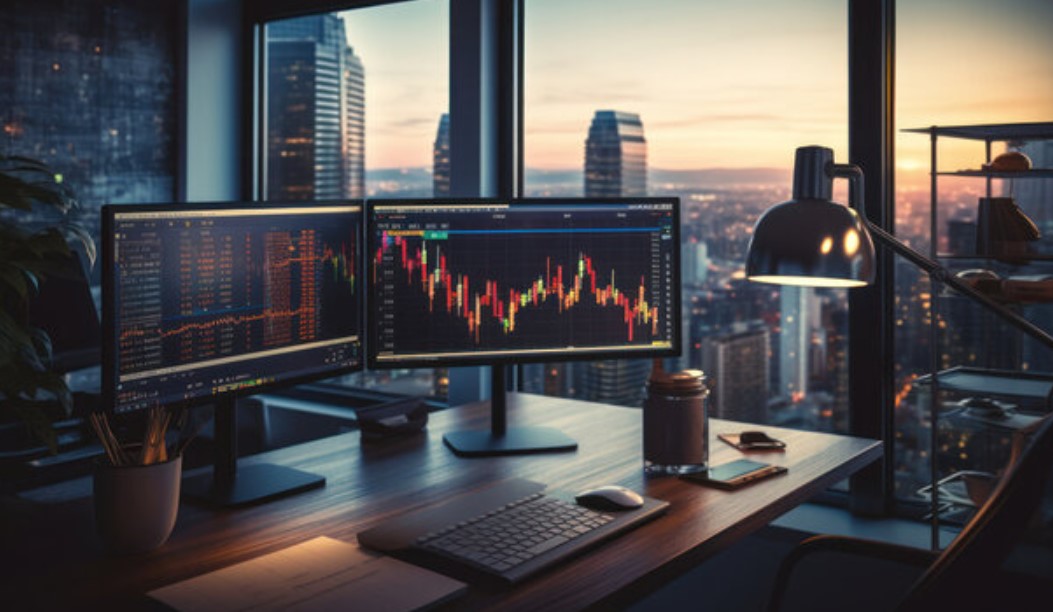
9 minute read
How to Start Forex Trading in Singapore: A Beginner’s Guide
from Exness
by Exness_Blog
Forex trading, also known as foreign exchange trading, is an exciting way to participate in the global financial markets. With Singapore being a major financial hub in Asia, it’s no surprise that forex trading has gained significant popularity among its residents. The city-state’s robust regulatory framework, advanced technological infrastructure, and access to global markets make it an ideal place for beginners to start their forex trading journey.
Top 4 Best Forex Brokers in Singapore
1️⃣ Exness: Open An Account or Visit Brokers 🏆
2️⃣ XM: Open An Account or Visit Brokers 💥
3️⃣ JustMarkets: Open An Account or Visit Brokers ✅
4️⃣ Quotex: Open An Account or Visit Brokers 🌐
If you’re new to forex trading and wondering how to get started in Singapore, this comprehensive guide will walk you through everything you need to know. From understanding the basics of forex trading to choosing a reliable broker and developing a trading strategy, we’ve got you covered. Let’s dive in!
What is Forex Trading?
Forex trading involves buying and selling currencies in the global foreign exchange market to profit from fluctuations in exchange rates. For example, if you believe the US dollar (USD) will strengthen against the Singapore dollar (SGD), you might buy USD/SGD and sell it later at a higher price to make a profit.
The forex market is the largest and most liquid financial market in the world, with a daily trading volume exceeding $7 trillion. It operates 24 hours a day, five days a week, making it accessible for traders in Singapore to trade at any time.
Why Trade Forex in Singapore?
Singapore offers several advantages for forex traders:
· Strong Regulation: The Monetary Authority of Singapore (MAS) regulates forex brokers, ensuring a safe and transparent trading environment.
· Global Connectivity: Singapore’s position as a financial hub provides access to international markets and cutting-edge trading platforms.
· Tax Benefits: Forex trading profits in Singapore are generally not taxed as capital gains, though you should consult a tax professional for clarity.
· Advanced Technology: High-speed internet and access to modern trading tools make it easy to trade efficiently.
Step-by-Step Guide to Start Forex Trading in Singapore
1. Understand the Basics of Forex Trading
Before diving into forex trading, you need to grasp the fundamentals. Here are some key concepts:
· Currency Pairs: Forex trading involves trading currency pairs, such as USD/SGD or EUR/USD. The first currency is the base currency, and the second is the quote currency.
· Pips: A pip is the smallest price movement in a currency pair, typically 0.0001 for most pairs.
· Leverage: Leverage allows you to control a larger position with a smaller amount of capital. For example, 100:1 leverage means you can trade $100,000 with just $1,000.
· Margin: This is the amount of money required to open a leveraged position.
· Spreads: The difference between the bid and ask price of a currency pair, which represents the broker’s fee.
Spend time learning these terms and how they apply to trading. Resources like online courses, books, and free webinars can help you build a strong foundation.
2. Educate Yourself on Market Analysis
Successful forex trading requires analyzing the market to make informed decisions. There are two main types of analysis:
· Technical Analysis: This involves studying price charts, patterns, and indicators like Moving Averages, Relative Strength Index (RSI), and Fibonacci retracement to predict future price movements.
· Fundamental Analysis: This focuses on economic factors, such as interest rates, inflation, and geopolitical events, that influence currency values.
As a beginner, start with technical analysis, as it’s easier to learn through charting tools. Platforms like MetaTrader 4 (MT4) or MetaTrader 5 (MT5), widely used in Singapore, offer built-in tools for technical analysis.
3. Choose a Reliable Forex Broker
Selecting a trustworthy broker is critical to your success. In Singapore, ensure the broker is regulated by the Monetary Authority of Singapore (MAS) or another reputable authority like the UK’s FCA or Australia’s ASIC. Here’s what to look for:
· Regulation: Verify that the broker is licensed and complies with MAS regulations.
· Trading Platform: Choose a broker offering user-friendly platforms like MT4, MT5, or cTrader.
· Spreads and Fees: Look for competitive spreads and low commission fees.
· Customer Support: Opt for a broker with responsive support, preferably available 24/5.
· Account Types: Check if they offer demo accounts, micro accounts, or Islamic (swap-free) accounts if needed.
Some popular MAS-regulated brokers include IG, Saxo Markets, and OANDA. Always read reviews and compare brokers before making a decision.

💥 Trade with Exness now: Open An Account or Visit Brokers 🏆
4. Open a Forex Trading Account
Once you’ve chosen a broker, follow these steps to open an account:
· Complete the Application: Provide personal details, including proof of identity (e.g., NRIC or passport) and proof of address.
· Verify Your Account: Submit the required documents for verification, as mandated by MAS regulations.
· Choose an Account Type: Start with a demo account to practice trading without risking real money. Once confident, switch to a live account.
· Deposit Funds: Most brokers accept deposits via bank transfers, credit/debit cards, or e-wallets like PayPal. Ensure the broker supports SGD for convenience.
5. Practice with a Demo Account
A demo account allows you to trade with virtual money while using real market data. This is an excellent way to:
· Test your trading strategies without financial risk.
· Familiarize yourself with the trading platform.
· Understand how leverage and margin work.
Spend at least 1–2 months practicing on a demo account before transitioning to a live account. Track your trades and analyze your performance to identify areas for improvement.
6. Develop a Trading Plan
A trading plan is a roadmap that outlines your goals, risk tolerance, and strategies. Here’s how to create one:
· Set Goals: Define what you want to achieve (e.g., consistent monthly profits or long-term wealth building).
· Determine Risk Tolerance: Decide how much of your capital you’re willing to risk per trade (typically 1–2% for beginners).
· Choose a Trading Style: Options include day trading (short-term trades), swing trading (holding positions for days), or position trading (long-term trades).
· Select Currency Pairs: Focus on major pairs like EUR/USD or USD/JPY, as they have high liquidity and lower spreads.
· Establish Entry and Exit Rules: Use technical indicators or fundamental events to decide when to enter or exit trades.
Stick to your plan and avoid emotional trading decisions, which can lead to significant losses.
7. Manage Your Risks
Risk management is crucial in forex trading to protect your capital. Here are some tips:
· Use Stop-Loss Orders: A stop-loss order automatically closes a trade when it reaches a certain loss level, limiting your exposure.
· Avoid Over-Leveraging: While leverage can amplify profits, it also increases losses. Start with low leverage (e.g., 10:1 or 20:1).
· Diversify Trades: Don’t put all your capital into one trade or currency pair.
· Keep Emotions in Check: Fear and greed can lead to impulsive decisions. Stick to your trading plan.
8. Stay Updated on Market News
The forex market is influenced by economic events, such as interest rate decisions, GDP reports, and geopolitical developments. Use resources like Bloomberg, Reuters, or the MAS website to stay informed. Many brokers also provide economic calendars that highlight upcoming events.
9. Start Trading with Real Money
Once you’re confident in your skills and strategy, transition to a live account. Start small, with an amount you can afford to lose. For example, many brokers allow you to open a micro account with as little as SGD 100–500. Gradually increase your trading size as you gain experience.
10. Keep Learning and Improving
Forex trading is a continuous learning process. Join trading communities in Singapore, attend webinars, or read books like Currency Trading for Dummies or The Little Book of Currency Trading. Analyze your trades regularly to identify what works and what doesn’t.
Legal and Regulatory Considerations in Singapore
The Monetary Authority of Singapore (MAS) oversees forex trading to ensure a fair and secure environment. Here are key regulations to be aware of:
· Licensing: Only trade with MAS-regulated brokers to avoid scams.
· Leverage Limits: MAS imposes leverage caps (e.g., 50:1 for major pairs) to protect retail traders.
· Investor Protection: MAS requires brokers to segregate client funds from their own, ensuring your money is safe even if the broker faces financial issues.
Always verify a broker’s license on the MAS website before depositing funds.
Common Mistakes to Avoid
· Trading Without a Plan: Entering trades without a strategy often leads to losses.
· Overtrading: Taking too many trades can result in high fees and emotional burnout.
· Ignoring Risk Management: Failing to use stop-loss orders or risking too much per trade can wipe out your account.
· Chasing Losses: Trying to recover losses by taking impulsive trades often leads to bigger losses.
· Not Using a Demo Account: Skipping practice can result in costly mistakes when trading with real money.
Tools and Resources for Forex Traders in Singapore
· Trading Platforms: MetaTrader 4/5, cTrader, or proprietary platforms offered by brokers.
· Charting Tools: TradingView for advanced charting and analysis.
· Economic Calendars: Websites like Forex Factory or Investing.com for tracking market events.
· Trading Communities: Join local groups like the Singapore Forex Traders Meetup or online forums like BabyPips.
· Mobile Apps: Most brokers offer mobile apps for trading on the go, compatible with iOS and Android.
How Much Money Do You Need to Start?
You don’t need a large amount to start forex trading in Singapore. Many brokers offer micro accounts with minimum deposits as low as SGD 100–500. However, consider the following:
· Capital: Start with an amount you can afford to lose, as forex trading carries risks.
· Leverage: With leverage, a small deposit can control larger positions, but use it cautiously.
· Trading Costs: Factor in spreads, commissions, and potential swap fees for overnight positions.
Tips for Success in Forex Trading
· Start Small: Begin with small trades to gain confidence and experience.
· Stay Disciplined: Follow your trading plan and avoid emotional decisions.
· Keep a Trading Journal: Record your trades, including entry/exit points, reasons for the trade, and outcomes.
· Learn from Mistakes: Analyze losing trades to understand what went wrong.
· Stay Patient: Forex trading is a skill that takes time to master. Don’t expect overnight success.
Conclusion
Starting forex trading in Singapore is an exciting opportunity to engage with the global financial markets. By understanding the basics, choosing a reliable MAS-regulated broker, practicing with a demo account, and developing a solid trading plan, you can set yourself up for success. Remember to prioritize risk management, stay informed, and continuously improve your skills.
Whether you’re looking to trade part-time or pursue forex trading as a full-time career, Singapore’s robust financial ecosystem provides the perfect environment to grow as a trader. Start your journey today, and with patience and discipline, you can navigate the forex market with confidence.
💥 Note: To enjoy the benefits of the partner code, such as trading fee rebates, you need to register with Exness through this link: Open An Account or Visit Brokers 🏆
Read more:







